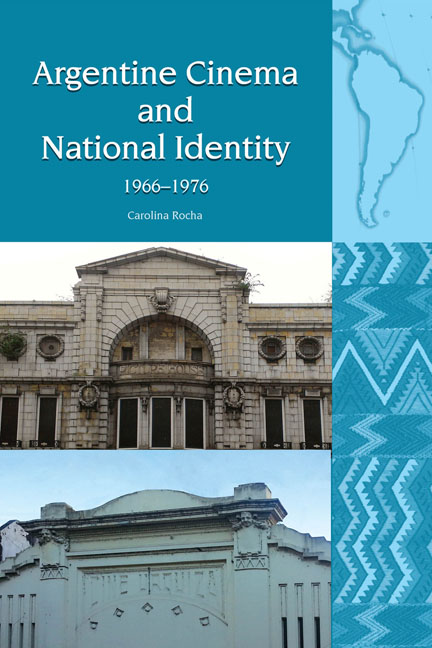Book contents
- Frontmatter
- In Memory of Paulina Piselli (1937–2017)
- Contents
- Acknowledgements
- Introduction
- Section I Argentine History and National Cinema, 1955–1976
- 1 Political and Social Tensions in Post-1955 Argentina
- 2 Argentine Cinema in the Late 1950s and Early 1960s
- 3 Argentine Cinema, 1966–1973
- 4 Argentine Cinema, 1973–1976
- Section II The Cinematic Gauchesque
- Section III Representing Founding Fathers
- Conclusion
- Bibliography
- Index
4 - Argentine Cinema, 1973–1976
from Section I - Argentine History and National Cinema, 1955–1976
- Frontmatter
- In Memory of Paulina Piselli (1937–2017)
- Contents
- Acknowledgements
- Introduction
- Section I Argentine History and National Cinema, 1955–1976
- 1 Political and Social Tensions in Post-1955 Argentina
- 2 Argentine Cinema in the Late 1950s and Early 1960s
- 3 Argentine Cinema, 1966–1973
- 4 Argentine Cinema, 1973–1976
- Section II The Cinematic Gauchesque
- Section III Representing Founding Fathers
- Conclusion
- Bibliography
- Index
Summary
As the revolución argentina came to an end in 1973, a new cinema law was signed on February 21. Law 20,170 of Promotion and Industrial Recuperation replaced Law 17,741 (implemented on May 14, 1968) and would remain in use until 1994. El heraldo decried the passing of this piece of legislation weeks before elections, which allowed the state to supervise all aspects of national cinema.1 Among the changes in the new ruling, Law 20,170 gave the NIC director the authority to act as legal representative of the institute or to name employees on its behalf. Another change mandated that film classification be decided after a screening. Films should be rated on whether they could benefit from compulsory exhibition and/or be exported. Finally, they had to be assessed on whether they could be classified as ‘of special interest.’ The reference to national culture and values was deployed to further restrict themes and maintain control over national film production.
As a result of the transition from a military to a democratic government, the NIC authorities and those in charge of censorship changed. Before leaving his position as head of the NIC, the longest tenure up to that point, Ridruejo stated that ‘Tomé un cine que había perdido fuerza con películas que tenían problemas para exhibirse y muchas veces para recuperar el dinero invertido’ [I took over an industry that had lost its power with films that struggled to be shown and often to recuperate investments] (‘La familia,’ 1973, 169). Certainly, the backlog of films produced in the early 1960s effectively ended during his term, but the loans given by the NIC predominantly went to directors who had a record of box office successes, often at the expense of quality. Ridruejo admitted that ‘a partir de la última ley se propende a un cine de mayor contenido y tratamiento y a una mejor colocación de las películas en el extranjero’ [after the last law, the trend was a cinema of more/better content and treatment and a better placement of films abroad] (‘La familia,’ 1973, 169). The trend of more content, however, was limited to a few historical or heritage films.
- Type
- Chapter
- Information
- Argentine Cinema and National Identity (1966–1976) , pp. 61 - 72Publisher: Liverpool University PressPrint publication year: 2018

